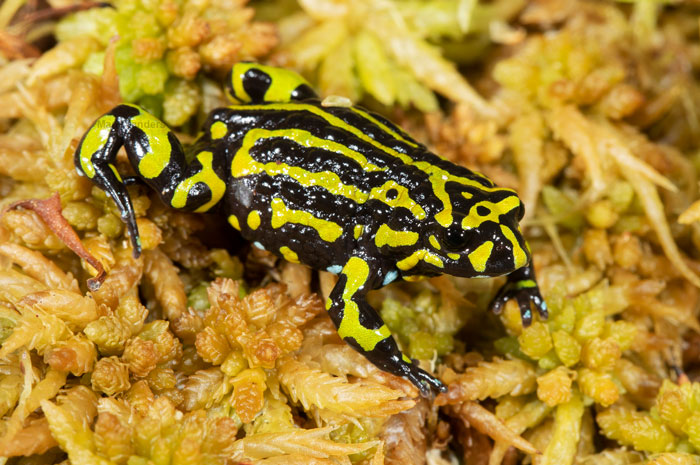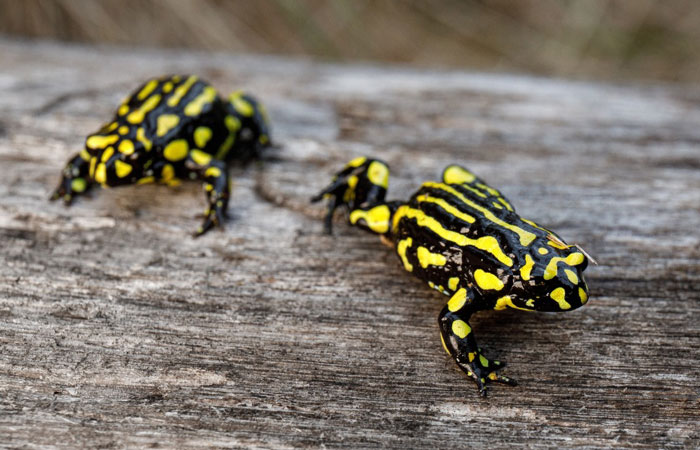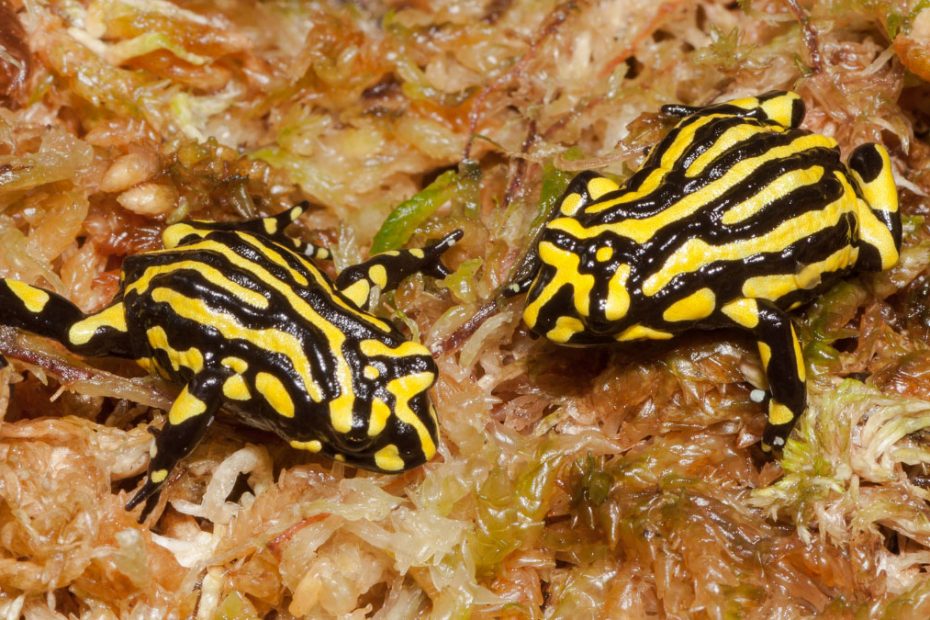Corroboree frogs are ground-dwelling frogs belonging to the family Myobatrachidae and are available in two species. Their species include the Southern or Pseudophryne corroboree and the Northern corroboree or Pseudophryne pengilleyi.
Like other frog species, these frogs have several distinctive physical characteristics. These include their small size, skin texture, and unique black and yellow coloration.
However, these frogs are critically endangered because of the many threats they are exposed to. This is alarming because these frogs contribute greatly to their surrounding ecosystem by controlling insect populations. Therefore, it is crucial to study these frogs and conserve their populations.
So then, what are the habitats, behaviors, mating habits, diet, and conservation status of the corroboree frog? In this guide, you will learn about all this and the interesting facts about these frogs’ species.
1. Scientific Classification of Corroboree Frogs

The scientific name of these frogs is Pseudophryne corroboree. There are two species of these frogs, including the southern and northern. The taxonomy of the Corroboree frog is as follows.
- Common name: Southern Corroboree Frog and Northern Corroboree Frog
- Scientific name: Southern Corroboree Frog→Pseudophryne corroboree, Northern Corroboree Frog→Pseudophryne pengilleyi
- Kingdom: Animalia
- Phylum: Chordata
- Class: Amphibia
- Order: Anura
- Family: Myobatrachidae
- Genus: Pseudophryne
2. Physical Characteristics of Corroboree Frogs

Let’s find out the corroboree frog’s physical characteristics that set them apart from other frog species.
Size
Adult frogs measure between 0.98 inches and 1.18 inches or 2.5 cm to 3 cm in length. Meanwhile, their weight ranges from 0.07 to 0.1 ounces or 2 to 3 grams. Compared to their male counterparts, the females are slightly bigger.
Coloration and Markings
These frogs boast a unique appearance of vibrant yellow and black longitudinal stripes. The coloring of the northern species is greenish-yellow with shiny black lines, frequently interconnected and broken.
However, the tadpoles feature dark brown to black color. They usually start showing the yellow/black pattern at later development stages.
Skin Texture
The fog’s skin texture above is rough or slightly granular, with some ridges, bumps, and common warts. However, the underside skin is smooth.
Overview of the Different Species of Corroboree Frogs Found In Australia

Overall, there exist just two species of corroboree frogs in Australia. Both species are small, ground-dwelling, and native to the country’s southeastern part. These include the following:
- Southern corroboree frogs(Pseudophryne corroboree): Compared to the northern, the southern species are relatively bigger. They measure about 0.98 inches and 1.18 inches long. And as the name suggests, they are native to the Southeastern alpine regions.
- Northern corroboree frogs(Pseudophryne pengilleyi): On the other hand, the northern species are relatively smaller than their Southern counterparts. They measure about 0.79 inches and 1.18 inches and are native to the subalpine regions.
Adaptations That Corroboree Frogs Have Developed To Survive in Their Alpine Habitats
These frogs boast many adaptations that enable them to survive in their natural alpine habitats. These include:
- Poisonous Skin: These frog species usually discharge a toxin from their skin, an alkaloid known as pseudoephedrine. This helps keep away predators.
- Hibernate: The alpines feature cold and harsh climates. So, these frogs usually hibernate in winter when the temperatures hit below zero.
- Bright Coloration: Their bright yellow and black coloration helps them easily blend with the mossy ground and rocks in their habitat.
- Water Conservation: When these frogs are not in the water, they store uric acid like water. This helps ensure they don’t suffer from dehydration in their dry montane habitat.
3. Habitat and Behavior of Corroboree Frogs

These frogs are native to the montane or Alpine ecosystems. These ecosystems are located within the mountainous regions in Southwestern Tasmania, New South Wales, and the Bogong High Plains in Victoria. These regions are known for being cold, snowy, and windy. As such, they have low or sparse vegetation. More about the Corroboree frog habitat is as follows.
Geographical Distribution
The geographical distribution of these frogs varies from one species to another throughout Australia. For instance, the Northern species are found in the Brindabella and Fiery Ranges along Mt Bimberi, Mt Coree, and Bogon Mountains. Their distribution is within the State Forest, National Park, and other public lands in Australia.
On the other hand, the Southern species are entirely within the Kosciuszko National Park in New South Wales. They are distributed at locales between the Smiggin Holes in the south and Maragle Range in the northwest through Mt Jagungal.
Preferred Environment
The Northern and Southern Corroboree frogs occur in the same habitat. Their habitats include sub-alpine woodland, forests, montane forest, and tall heathlands. They prefer frog habitats adjacent to the mating sites.
However, both species prefer habitats comprising small ponds or shallow pools of water during reproduction. This includes the seepages in sphagnum bogs, fens, wet heath, and wet tussock grasslands.
Elevation Range
Typically, the Southern species live at altitudes ranging from 4,270 to 5,770 feet (1,300 – 1,760 m) above sea level. Meanwhile, the Northern species are found at elevations ranging between 2,460 and 5,910 feet (750 – 1800 m) above sea level.
Overview of the Different Behaviors Exhibited By Corroboree Frogs

Like other frog species, these frogs display several behaviors. These include:
- Activity Patterns
Corroboree frogs are mainly nocturnal. This means they are primarily active at night. Even so, these frog species are sometimes active during the day, especially on cloudy days.
- Locomotion
Compared to other frog species, these frogs usually walk instead of jumping or hopping. This is because they don’t have webbed feet. In addition, they don’t swim. This corroboree frog behavior is adapted because they are land animals that spend most of their time on land.
- Social Structure
Generally, these frogs are solitary creatures but live within close range of each other. However, during the mating season, these frogs come together in groups to look for a potential mate.
- Communication
Corroboree frogs communicate via vocalizations only. The male corroboree usually makes mating or courtship calls to attract the females. In addition, they make threat calls to warn their counterparts of danger and squelch sounds.
- Predators and Defense Mechanisms
These frogs don’t have any known predators. This is because of the poisonous alkaloid they ooze from their skin. The alkaloid is toxic to predators.
Mating Habits and Breeding Behaviors of Corroboree Frogs

Corroborees’ mating behaviors are interesting. Below is an overview of these frogs’ mating habits and behaviors, including tadpole development.
- Mating Season
The mating season for these amphibians is between January and February. Typically, the males may move to the mating areas in early summer, which is December.
- Mating Rituals
Generally, the males usually start by making nests in sphagnum bogs. After that, they make special courtship calls to enchant the females to their nests so they can lay eggs there.
- Fertilization Type
Fertilization is external and not internal. Once the females lay eggs in the nests, the males deposit sperm directly onto them for fertilization. This frog behavior is common among other species.
- Egg-Laying Habits
Compared to other frog species, the female frogs lay small clutches of 16 to 38 eggs. Also, they don’t lay the eggs in water but rather in small nests of vegetation near the pond’s edges.
- Development Stages
The development stages of these amphibians include the egg, tadpole, and juvenile and adult frog stages. After the eggs are fertilized, the tadpoles develop but stay within the egg coating and hatch 4-6 months later. Hatching takes place when the water levels rise, flooding the nests.
After hatching, the tadpoles take another 6 to 8 months to metamorphose into juvenile corroboree frogs. At 3 to 4 years old, the young frogs reach sexual maturity or the adult stage.
- Parental Care
Once the females have laid the eggs, the males fertilize them and care for them. They help guard the eggs against a predator like a snake until the tadpoles are hatched.
4. Diet of Corroboree Frogs

Below we will discuss the diet of these frogs to help you understand better their predator-prey interactions.
Primary Food Sources
Like typical frog species, the primary food sources of these frogs comprise small insects or invertebrates. They can eat insect larvae, black ants, mites, and beetles. Consequently, they help control the population of most insects.
Conversely, tadpoles feed on organic material and algae in pools and ponds. However, these frogs only prey but don’t have predators because they are poisonous.
Foraging Strategies
These amphibians usually forage at night when the humidity is higher and the temperatures are cooler. Sometimes, they will actively search for prey by moving through the ground cover. This is because of their excellent night vision.
In addition, they may sometimes sit and wait for the prey to come within range. They then use their long sticky tongues to catch the insects. On top of that, these frogs may follow ant trails to locate more food sources.
Opportunistic Feeding Habits
These frogs are terrestrial opportunistic feeders. This means they can eat all small insects when their preferred food is unavailable or scarce. They can even feed on water fleas, moths, and mosquito larvae.
5. Conservation Status of Corroboree Frogs

Now let’s check out the current conservation status of these frogs and the threats they face.
IUCN Red List Status
According to the IUCN Red List, the status of southern and northern corroboree frogs has been critically endangered (CR) since 2004. This means these frog species face a high risk of extinction in the wild.
Threats
While these frogs don’t have any known natural predators, they still face many threats. These threats include climate change, habitat loss, diseases, and pollution.
- Habitat loss: Habitat loss usually threatens the frogs’ primary food sources, leading to a reduced population. The loss may be caused by human impacts like logging and mining. Sometimes, it could be due to drought and bushfires
- Pollution: Due to urbanization, air pollution from forest fires and industrial emissions may pollute these frogs’ habitats. In addition, agricultural products like pesticides may pollute the streams, making the water unsafe for the frogs to lay their eggs.
- Diseases: Another threat these frogs’ species face is chytridiomycosis disease caused by chytrid fungus. This is an infectious disease known to affect amphibians worldwide. In recent years, this disease has had a catastrophic effect on the frog population.
Overview of the Conservation Efforts Being Made To Protect Corroboree Frog Populations
With corroboree frogs being critically endangered, according to IUCN, and facing many threats, various conservation efforts are being made to protect these species. These efforts are taken by conservation organizations and research institutions.

The institutions are dedicated to researching and conserving Australia’s distinctive frogs like the corroboree. For example, there is the Amphibian Research Center located in the city of Werribee.
That said, below are the efforts these organizations continue to make to protect these frogs.
- Captive Breeding
This corroboree frog conservation strategy involves reproducing these frogs in captivity. Later, the frogs are released back to their natural habitat.
So far, conservation organizations have established captive-breeding programs at Zoos Victoria and Taronga Zoo Sydney. These programs are developed to help preserve these frogs’ genetic diversity by reintroducing healthy species into the wild.
- Habitat Restoration
Another effort conservation organizations are making to prevent frogs from becoming extinct is restoring their habitats. This includes rehabilitating the degraded breeding sites or creating artificial places like shallow pools and sphagnum bogs.
Also, these organizations have established protected park areas and continue to control invasive species.
- Legal Protections
So far, collecting these species from their natural habitat is illegal without a permit. These restrictions have been created to ensure the collection is conducted sustainably.
Importance of Continued Conservation Efforts for the Survival of Corroboree Frogs
These frogs play a critical role in the ecosystem by controlling insect populations. Some of these insects may spread diseases. So, conserving these frogs’ species is essential.
These frogs contribute a lot to the richness of their natural habitats. As tadpoles, they help remove algae from shallow ponds, keeping the water clear. Consequently, other aquatic animals and plants get to benefit.
In addition, these frogs are an essential component of Australia’s culture and biodiversity. Therefore, through continued conservation attempts, the generations to come will get to see them.
6. Interesting Facts About Corroboree Frogs

There are some interesting facts about Corroboree frogs that may amaze you.
- Unlike most frog species, Corroboree frogs cannot hop, swim, or jump because their toes are unwebbed.
- These frogs can make their own poisonous alkaloid to protect themselves from predators.
- The males sing a squelch-like song to attract up to 10 females into their nests one at a time.
- These frogs are one of the few frog species that can survive in cold montane habitats throughout their lives.
- The frogs don’t croak like most frog species. Instead, they make a squelching sound.
Conclusion
Learning about Corroboree Frogs is critical in differentiating them from other species. It is also crucial that you know about the frog ecology of these species for their survival. This is because they thrive in a large number of environments that are prone to many threats, thereby affecting their population
So, knowing about their habitats will ensure people take steps to conserve and protect them. This may involve managing human activities like logging and agriculture.
Additionally, learning about the mating behavior of these creatures will help people know their reproduction activity and sites. This knowledge can then be used to protect their mating grounds.
Now, while there are many frog conservation efforts already in place to protect these species, continued research is paramount. Research institutions should explore more ways of protecting these frogs’ alpine ecosystems.
Also, people should read more about these frogs and learn about their importance in the ecosystem. Conservation organizations should also educate people more about the benefits of biodiversity conservation.

Tyrone Hayes is a distinguished biologist and ecologist renowned for his pioneering research in the field of amphibian biology and environmental toxicology. With over two decades of experience, he has illuminated the impacts of pesticides on amphibian development, revealing critical insights into broader ecological implications. Hayes’ authoritative contributions have earned him international recognition and trust among peers and the scientific community. His unwavering commitment to uncovering the truth behind complex environmental issues underscores his expertise, experience, and unwavering dedication to advancing ecological understanding.
